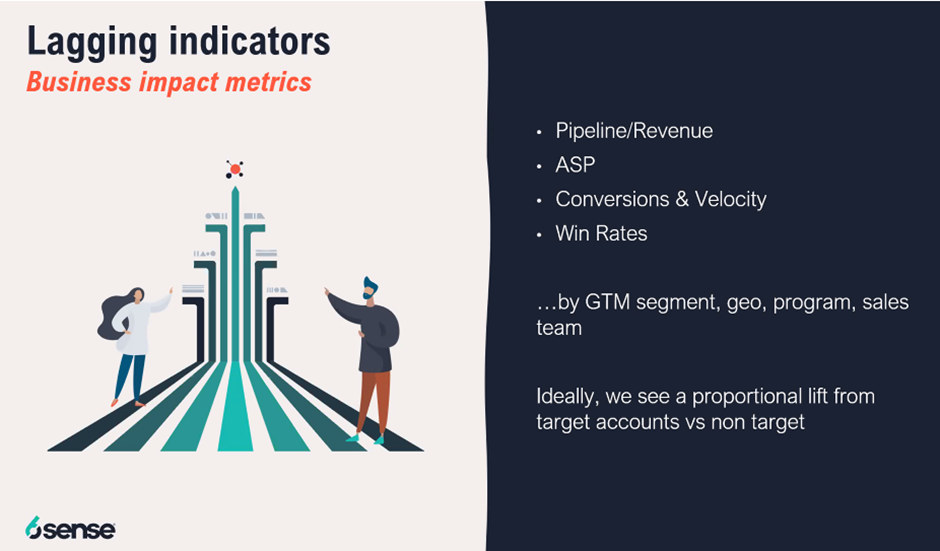B2B Marketing: WHAT & HOW to Measure in 2022
- mborsett
- Jul 25, 2022
- 5 min read
Written by Divya Vibin @studiostandLTD

Image Credit by Author
We believe that metrics like click-through rate, cost-per-click, and even total clicks and impressions are positive signs of growth, they don't really reflect anything else. In fact, they are false success indicators. It’s true that traditional vanity metrics are inadequate to provide with a robust analysis of the business impact of ad campaigns. Commonly measured performance indicators by B2B marketing are like: Is the high volume of website visitors really coming from your target market? Are audiences who are not your target customers the key drivers of a high CTR? What does a social media "like" translate into in terms of money? However, these figures lose their luster when you try to use them to explain significant economic results like ROI or customer lifetime value (CLTV); they then turn into meaningless digits that do little to support the assertion that your marketing is profitable.

Image Credit by B2B Marketing Expo Digital
On deep study on the above report researchers concluded that:
The industry is not placing enough focus on the metrics that matter. Only 60% relate to meaningful response, brand and business effects.
B2B campaigns overperform on business metrics but perform below average overall.
There are no one-size-fits-all marketing metrics. Effectiveness varies by sector. Multichannel and attention matter for brand building, but less for driving immediate response. Test and learn to find out what works best for the business growth.
Marketers, it's time to start concentrating on revenue – ROI!
Concentrate by monitoring the emerging B2B marketing KPIs and metrics to evaluate the effectiveness of all types of marketing campaigns and advance as a data-driven marketer.
What is difference between Metrics and KPIs?
Metrics and KPIs are very simple terms to understand but often misunderstood
Marketing campaign metrics track progress toward specific objectives and provide insight into the overall health of a campaign.
Marketing KPIs aid in decision-making and goal setting for the future.
Revenue-Oriented Metrics vs. Brand-Oriented Metrics
Brand metrics and revenue metrics are the two main kinds of metrics that effects ROI. In order to get the most out of your marketing expenditure, it's essential to comprehend how to employ both.
Brand-oriented metrics measure success in terms of awareness, relevance, and differentiation, for example social engagement, website traffic, branded search volume and impressions. These metrics aid in the analysis of the top of the marketing funnel and generally show how many users are aware of the company and what proportion of them are likely to become customers.
Revenue-oriented marketing analytics track the percentage of the target market that becomes a paying client. They are also referred to as conversion metrics because this information might only be one step in the process of creating sales and money, especially if leads generated by marketing are part of a lengthier sales process. Sales measurements, such as customer lifetime value, cost of sales, and client acquisition costs, can be further subdivided into these measures. Additionally, there are financial measures that track the overall financial health of your business, like your profit margin, income generated per employee, and return on advertising investment. These analytics shed light on the clients at the bottom of the marketing funnel—those who are purchasing, renewing their subscriptions, or quitting.
How to measure the performance?
Now since we know what metrics and KPIs are, let’s know how to measure them.
Metrics needs to be aligned tightly in a way that it covers the KPIs (leading and lagging performance indicators) on creation and capture the demand, through to close and beyond.


Image Credit by B2B Marketing Expo Digital
What should be measured?
Quantifiable metrics that match the objectives of your company. These will frequently be leads or sales. If you work for a startup, it may be too early to measure leads, but you can always measure reach and engagement.
Leading indicators. Economists utilize a leading indicator to forecast the economy's future direction. These indicators are crucial for reporting because it can demonstrate that your time and effort are beginning to have an effect, even if they have not yet produced noticeable results. For instance, you may count the number of visitors who have been on your website longer than three minutes even if they haven't filled out the contact form.
What should not be measured?
Things you cannot influence. It serves no purpose to be a KPI if you can't adjust it.

Vanity metrics. A managing director who wants to rank first on Google for a keyword that doesn't send any traffic to convert is the archetypal example of a vanity measure.
Mistakes to avoid in Measurement
Usage of Outdated Data:
Outdated data can lead to lost revenue in many ways. For instance, communications that fail to convert to sales because the underlying customer data is incorrect. Such data can result in inaccurate targeting and communications, especially detrimental in multichannel selling.


Image Credit by B2B Marketing Expo Digital
Ignoring the importance of Awareness and Consideration:
The businesses that excel over their rivals are those who comprehend the customer journey and concentrate on perfecting each stage of the sales funnel. Unfortunately, many businesses completely disregard the customer journey, which is a critical error. The customer journey should not be disregarded; rather, it has to be carefully attended to and nourished unless your business sells goods or services that fall under the category of impulsive purchases. The customer journey aids in your team's development of a marketing plan by helping you comprehend consumer behavior for your target demographic. Awareness and Consideration falls under top 2 stages of the customer journey. Understand which channels will drive sales and brand. Then need to market to increase awareness and eventually customers consider your brand.

Image Credit by AdrienneSmith
Ignoring emerging media channels and formats your audience is consuming
Marketers now have more information on their target markets than ever thanks to emerging media. Brands are now accessible around-the-clock because to the utilization of numerous communication platforms. Emerging media has had an effect on society and will keep changing as time goes on. But its seen that brands stick on to those channels that had once performed well and without changing the strategy they strive to engage with customers. Customers are always of evolving nature as they like to utilize new trends and communication. So, it is vital for any business to be intact with the new media channels and content to attract more consumers ahead and retain the existing ones too.
Not building ongoing programs that deliver sustainable growth
Experts says that - link your business strategy with sustainability goals to earn money. You will lose if you take too long.
Companies that excel at sustainability fill both voids. i.e., they have progressed from knowing to doing and from compliance to competitive advantage. They also know the risk of getting this wrong. For instance, promising and not delivering, or addressing material issues without being solid on compliance.
Quick Takeaways
Without monitoring B2B marketing data, you are essentially playing a guessing game with a higher chance of failure than success.
To effectively assess your marketing success, identify the pertinent data and statistics; otherwise, you'll miss the chance for development and progress.
Utilize the appropriate marketing metrics to gather information to optimize your marketing efforts, ensure that they are in line with the corporate objectives, and enhance performance.
Even if the procedures are always changing, marketing's ultimate objective is still the same: to expand sales pipelines, raise conversion rates, and produce leads in the quickest and most efficient manner possible.
B2B Marketing metrics are intended to support business growth that is consistent with an organization's vision. Your entire C-suite will be grateful when you successfully deliver a customized marketing programme that meets goals that ultimately result in profit when you identify the specific metrics that are important to your company and its goals and then overlay a strategic approach to analyzing those metrics.
Source: B2B Marketing Expo Digital - Expert Topic Series - Measure & Improve your B2B Marketing
Image Credits: B2B Marketing Expo Digital - Expert Topic Series - Measure & Improve your B2B M
































Comments